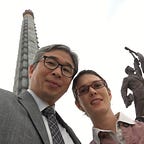North and South Koreans Unify over Treatment for Disabilities
Ignis Community hosted the third training in treatment for children with disabilities for North Korean and Chinese doctors from March 25- April 3rd. Eight North Korean doctors trained in Bobath Therapy, which is a specialized treatment for children with cerebral palsy, in Shanghai, China. The joint training for both Chinese and North Korean medical professionals was an invaluable time of broadening the doctors’ horizons, expanding upon their knowledge, and increasing their skills and expertise on cerebral palsy.
Medical training was provided by seven South Korean medical professionals from the Seoul Rehabilitation Hospital. Initially, regulations made it difficult for the North and South Koreans to work well together. But as the South Korean medical professionals provided high level of instruction and experience in the training, the North Korean doctors quickly warmed up to their fellow Koreans.
This is not a simple accomplishment for citizens of a country that have been divided for approximately 70 years. Last year both North and South Korea celebrated the 70th Anniversaries for the founding their nations. The division of their country into the North and the South, though, was never a Korean intention.
At the end of World War II when Korea was liberated from the Japanese Occupation, Allied Forces went into the country to ensure its freedom. Russia entered from the north and U.S. forces entered from the south. They met at the 38th Parallel.
Unfortunately, the Cold War Era was also just beginning. Instead of liberating a unified Korea, Russian influence helped establish a Communist government in the North, while U.S. forces supported a Democratic government in the South. Both nations were officially established in 1948.
Two years following the establishment of the two countries, the Korean War broke out. It became one of the bloodiest civil wars in all of history. After three years of devastating war, the countries were back where they started: separated at the 38th Parallel.
Therefore, North and South Koreans coming together for the treatment of children with cerebral palsy is a little giant step. It demonstrates to all of us the potential for reconciliation not only between countries but also in our personal lives. It takes effort to overcome past hurts. We can all identify with broken relationships in our lives. However, reconciliation does not come by chance. For true reconciliation to take place, it requires considerable effort.
North Korea has a strong drive for reunification. This is a soft spot for all Koreans, but particularly for North Koreans. A regular part of Ignis Community’s work is bringing in donors and sponsors of our projects to witness first-hand the effect our humanitarian work was having on the common people of North Korea. On one particular trip, we brought in several guests consisting of supporters for our kindergartens in the special economic zone. Because of this special visit, one of the childcare centers we supported decided to perform for our guests. The children and the teachers took turns singing, and then it was the guests’ turn.
Towards the end of our time together at the kindergarten, we gathered in a circle, holding hands, singing songs of unification and sentimentality. Many tears fell. To my surprise, most of those tears were not just ours but the teachers’. In this schoolroom were Koreans from the North, as well as Koreans formerly from the South, from the U.S., and from Uzbekistan. And then there was me, Joy, a non-Korean privileged to take part in this special Korean bonding time. When I saw the expression on the faces of the teachers and their tears, my eyes, too, started watering! Working in unity makes a huge difference in North Korea (Excerpt from Discovering Joy: Ten Years in North Korea, www.joyinnorthkorea.com).
This past week Ignis Community experienced for the second time such an experience. As training began at the end of March, distrust and skepticism were high between the North and South Koreans. But by the end of the training, they were holding hands and smiling. Like Ignis’ prior experience, North and South Koreans unified over song. This time the song was one that the two countries sang in common. There was not a dry eye in the place! Even the most stoic of doctors found themselves shedding a tear or two.
I believe this is an unprecedented example of unity. It is a small start to healing and reconciliation between a once unified nation. Unity is found on common ground. In this case, the North and South Korean medical professionals were united over treatment for children with developmental disabilities. But the doctors learned more than just medical knowledge. They learned that humanity can be found in all people: in the disabled, in our next-door neighbors, and even in the most separated and broken relationships! It is a great example of reconciliation for us all to learn from, with it being applicable to both our professional and personal lives.
